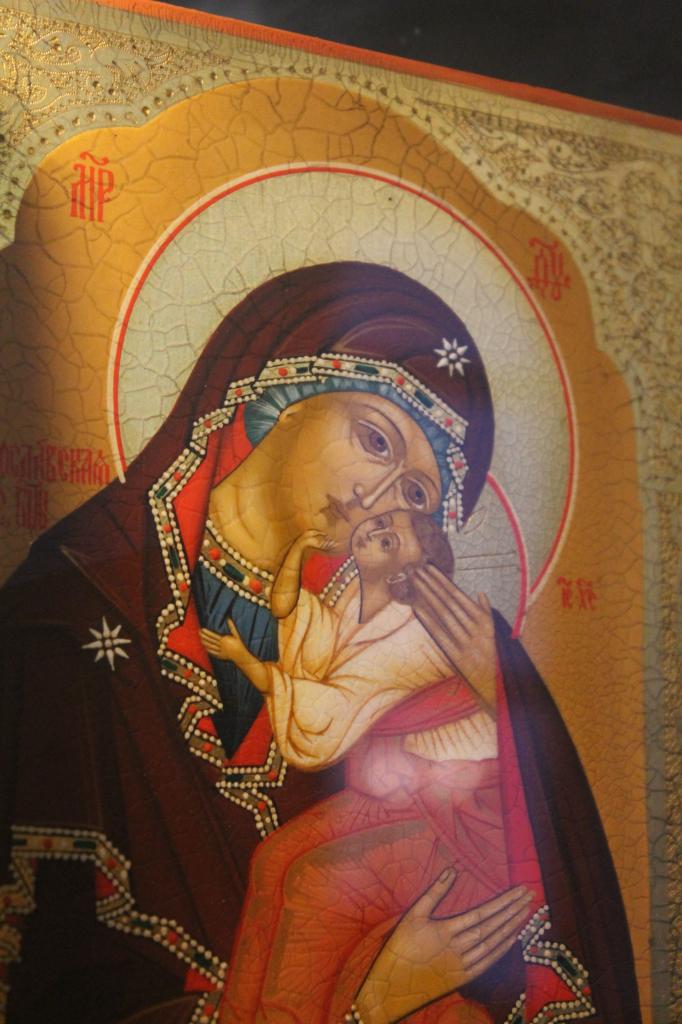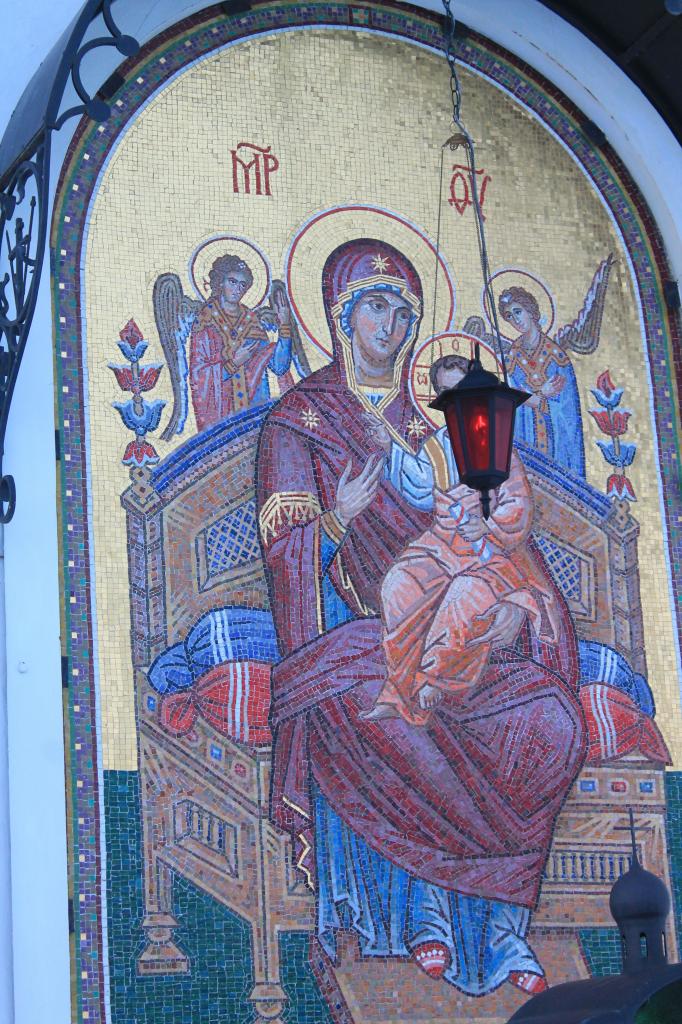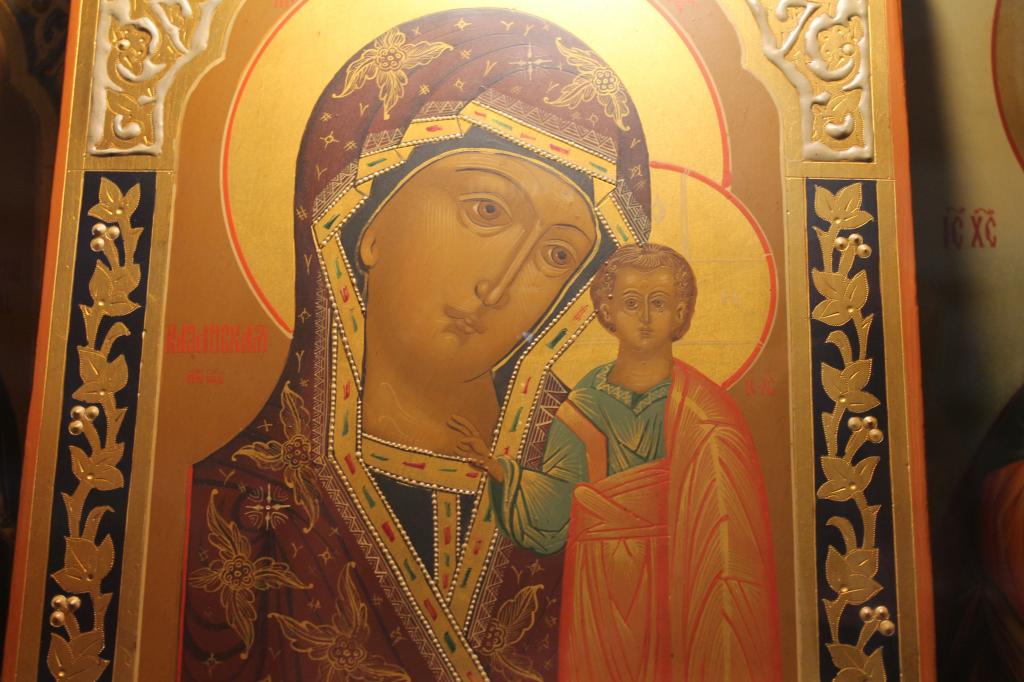When talking about the miraculous icons of the Mother of God found in the Yaroslavl land, they usually mean the image brought to the city by the holy princes Vasily and Konstantin. However, the Yaroslavl icon of the Mother of God is not the only miraculous image of the Blessed Virgin associated with the city. No less famous and revered are the Kazan and Pechersk icons.
Iconography of the image of the Yaroslavl Mother of God
The true image of the Yaroslavl Mother of God is lost. This icon is known for the numerous lists made from it at different times. The most ancient copy is considered to be the one that is stored in the collection of the Tretyakov Gallery in Moscow. This copy was made in the 15th century. The Yaroslavl icon of the Mother of God, or rather a copy from the original miraculous image, made in 1500, according to legend, was transferred to the Trinity-Sergius Lavra as a contribution, the widow of the last of the specific princes of the city. The collection of the Tretyakov Gallery also contains another list of icons made at the end of the 15th century. Art historians believe that it is more valuable as a work of art.
Which of the copies of the icon is closest to the original image, of course, it is impossible to establish. However, by studying the early lists, one can imagine what the Yaroslavl icon of the Mother of God was.
From the history of the image of the Yaroslavl Mother of God
The history of the image of the Yaroslavl land has not been reliably established. In other words, the appearance of the miraculous Yaroslavl icon of the Mother of God is known solely according to traditions and legends. It is indisputable and reliable only the time of acquiring the image - the XIII century. That is, the moment of the appearance of the icon coincided with the beginning of a difficult test for the Russian lands - the rule of the Mongol-Tatar tribes.
According to legend, princes Konstantin and Vasily Vsevolodovichi brought the image to the city, later canonized. The brothers were brought up by the Grand Duke George Vsevolodovich Vladimirsky, who was the first to render a worthy rebuff to the hordes of foreign invaders. Their father was Yaroslavl Prince Vsevolod Konstantinovich. And the mother of the future holy brothers was Princess Marina, daughter of Oleg Kursky.
Vasily Vsevolodovich accepted the reign of Yaroslavl in 1238, after a battle with enemies near the banks of the River Sit. This small river still flows through the Yaroslavl lands, carrying its waters to the Volga. In the battle that served as the forerunner of Kulikovsky, Grand Duke George and the Yaroslavl ruler Vsevolod Konstantinovich were killed. Rostov Prince Vasilko was full and later brutally tortured.
Arriving at the reign of Yaroslavl, Vasily, along with his younger brother Konstantin, brought with him an icon. With the blessing of Bishop Cyril of Rostov, the image was placed in a stone church, built in 1215.
As the icon turned out to be in the hands of the brothers, the legends are silent. Historians and art historians, however, believe that it was brought from Kiev or from Vladimir. But be that as it may, people in need, suffering and grieving immediately reached the image. The icon almost immediately gained the glory of the Miracle Worker, and the day of its establishment in the temple became a date of veneration. Before the revolution, this date was called the Day of the Appearance of the Icon of the Blessed Virgin Mary of Yaroslavl. The image is read on June 21 according to the Gregorian style, on the same day the church commemorates the brothers Vasily and Konstantin - the holy princes of the land of Yaroslavl.
At the beginning of the 16th century, the relics of Princes Vsevolodovich were transferred to the Assumption Cathedral of Yaroslavl . At the same time, the image of the Virgin was moved to this temple. From the moment of its placement in the iconostasis of the cathedral, it began to be considered the patroness of the Yaroslavl land. King John III came to worship her. The first ruler of the Romanov dynasty, Mikhail Fedorovich, also prayed at this image on the way from Kostroma to Moscow. His Grace Prince Dimitry Pozharsky near her received a blessing from Metropolitan Cyril before the militia moved to liberate Moscow. Nicholas II, the last autocrat of the Russian land, also prayed before the image. He came to bow to the icon in 1913.
The Assumption Cathedral was closed and looted at the beginning of the last century. At that moment, the miraculous icon disappeared. From time to time, information appears in the media that the image is found in attics, in basements, and in antique shops, however, the icon is still officially considered lost. The found images are copies, lists that are restored and returned to the temples of the city.
How does this image help? Does the icon have its own temple?
In 2011, the modern temple of the Yaroslavl Icon of the Mother of God was laid. It is part of a large temple complex, which, upon completion of construction, will be named after the founder of the city, Yaroslav the Wise. The project and the construction itself were blessed by the Metropolitan of the land of Yaroslavl Panteleimon. The first stone was laid on the foundation of the Small Church on August 22, and in the last days of November the Metropolitan consecrated the church and served the liturgy in it. However, the iconostasis of this temple does not possess any of the ancient lists with the Yaroslavl Mother of God. This church is located on Frunze Avenue and its doors are open for parishioners from early morning to late evening.

How does this icon help? It was acquired in an extremely difficult historical period. People not only suffered from the yoke of invaders, as a result of bloody battles in many families were crippled, sick, blind. Of course, all of them, each with their own grief, bowed to the Virgin.
The image of the Yaroslavl Mother of God is considered to be healing from the most serious ailments and injuries. Prayer in front of the icon is able to restore sight to the blind, to cure a hopeless patient. Also, the Mother of God protects the home and integrity, the well-being of the family.
Yaroslavl Pechersk Icon of the Mother of God
This miraculous image is also lost. The day of church veneration is May 14, according to Julian style.
The Yaroslavl Pechersk Icon of the Mother of God was acquired not so long ago, in comparison with its more "famous namesake." It happened at the beginning of the XIX century. One of the residents of Yaroslavl for many years suffered from a serious mental illness, which very much resembled what is now called depression. This woman's name was Alexandra Dobychkina.
One of the nights of 1823, Alexandra Dmitrievna forgot a short, painful dream, in which she saw a temple with an unusual icon, as if laid out on a wall. Considering the dream of things, the patient set off on the streets of the city. It should be noted that it was extremely difficult to find a vaguely dreamy temple at that time in Yaroslavl, since several churches stood on each street.
How many days, weeks, or months Alexandra Dmitrievna searched for the temple is not entirely clear. However, it is known for certain when she discovered it. It happened on May 1st. Having entered the territory of the Transfiguration Monastery, for some reason a woman went to the Bishop’s house and stood up, not believing her eyes. In front of her stood a church from a dream. It was a temple of the Origin of honest trees. Entering the prayer hall, Alexandra Dmitrievna immediately saw the image that appeared in a dream, went up to him and fell, huddled in convulsions. Having regained consciousness, the woman gained confidence in the speedy healing and began to come and pray daily in front of the fresco with the image of the Virgin.
After the complete healing of Alexandra Dmitrievna, who had been suffering for more than 17 years, the fresco gained fame, and then became miraculous. She began to be called the Yaroslavl Cave Icon of the Mother of God. When the monastery was closed and plundered at the beginning of the last century, the fresco was barbarously destroyed, chipped from the wall.

The type of iconography of this image is Panahranta. Our Lady is portrayed as Queen of Heaven, she occupies the Throne, holding Jesus. This type of icon painting was characteristic of the masters of Constantinople, or of Constantinople. Historians and art historians believe that the Yaroslavl fresco was a copy of the ancient icon from the Kiev-Pechersk monastery, lost long before the revolution. And she, in turn, was a list with the image of the Mother of God from the church of Sofia of Constantinople. The closest to the destroyed Yaroslavl miraculous fresco in artistic execution is the famous icon of the Mother of God “Sovereign”.
Yaroslavl Kazan Icon of the Mother of God
The glory of the Kazan image of the Virgin has been living among the people for centuries. She easily endured decades of godlessness, which cannot be said about the icon itself, which is one of the most revered in Russia.
The appearance of the image took place at the end of the 16th century in Kazan. Fires raged in the city, and from the many buildings there were only ashes. One little girl saw a dream in which she saw an image under burnt rubble. The next day, with a large crowd of people, the icon was removed from under the ashes exactly where the child indicated. The first miraculous healings occurred during the transfer of the icon from the ashes to the nearest temple. The girl who saw the prophetic dream was called Matrona. Years later, she became the first novice of the Bogoroditsky girl’s monastery, built on the site of the icon. She tonsured Matron under the name of the Moors.

But in the history of the icon, only the moment of its acquisition is clear. Everything else is covered in mystery and is the subject of controversy among scientists. Tsar Ivan Vasilievich, known as the Terrible, became interested in the image. A list with a miraculous icon was sent to him. And this is the first obscurity in the fate of the image. Could the autocrat, known not only for his violent disposition and, as they would say now, for the lack of adequacy, but also for the utmost piety, send a copy of the icon?
It is possible that the original departed for Moscow, while the list from it remained in Kazan. However, to clarify this point today is not possible. When collecting the first militia, the Protopop of the Annunciation Cathedral of Kazan brought a list from the image under the walls of Moscow. However, blessings and copies of the icon were not enough, the militia was defeated by the Poles.
But curiously, the militia broke up after the murder of Lyapunov, who headed it. It happened in 1611. And even before 1609, in a small settlement near Yaroslavl, which was called Romanov, an image of the Mother of God appeared, indistinguishable from the description of Kazan. The exact date of the appearance of the icon, near which miraculous healings took place, is not known. According to legend, it was bought in Kazan and brought to Romanov by a certain Gerasim, who suffered from numbness of his arm around 1588.
In 1609, a threat of looting hung over Romanov, and the image was urgently taken to Yaroslavl. The siege of the city lasted 24 long days, and all this time before the image they prayed relentlessly. The Poles retreated. The image was considered to be a patron of the city and protecting it from foreign invaders. And so the Yaroslavl Kazan Icon of the Mother of God appeared.
In 1610, a church was laid for the Yaroslavl Kazan image of the Virgin, cells were built near it for the surviving attendants of the Nativity Monastery, destroyed by Polish invaders. Thus was the beginning of a new monastery.
The protopop of the Kazan Annunciation Cathedral, after the defeat of the militia, along with the list of icons, was in Yaroslavl. When the second militia gathered, Dmitry Pozharsky prayed and received a blessing in the same city. The prince wished to have the miraculous Kazan icon on the battlefield. Further, the path of the image is again shrouded in mystery. Which of the icons accompanied Pozharsky’s army and returned to Yaroslavl, and which went to Kazan — no one knows. There is no clarity in historical and church documents.
Only one thing is known for certain - near the Yaroslavl Kazan Icon of the Mother of God miraculous, absolutely inexplicable healings constantly occurred.
The image befell the same fate as many other shrines of the Yaroslavl land. Kazan Monastery was closed and looted at the beginning of the last century. The icon was transferred to the Holy Cross Exaltation Church, where the southern part of the altar was consecrated in honor of the image back in 1690. The chapel of the Icon of the Mother of God was also placed there. However, in 1925 the church was sacked. Among the stolen turned out to be a miraculous image. In 1930 the temple was closed.
The iconographic type of this image is Hodegetria. According to legend, its founder is the evangelist Luke himself. The baby on such icons is in front of the Virgin and his figure is deployed to the people.
The fate of this icon remains unknown. To date, two copies are considered closest to the original. One of them is in the museum of Yaroslavl, in the Metropolitan Chambers. The other is the main shrine of the newly opened Kazan monastery, and with it the procession is annually performed in the city of Tutaev, which was formerly called Romanov.